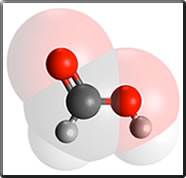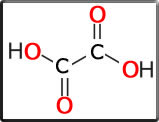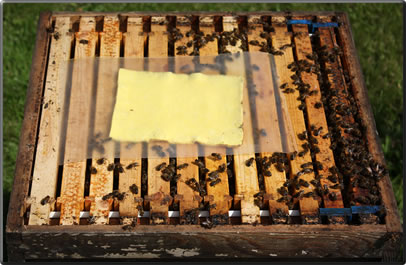Varroa 2
Formic Acid
Formic acid is a natural miticide. It was first isolated by the English naturalist John Wray in 1671 by distilling wood ants. Formic acid or methanoic acid is the first of an homologous series of organic acids. The second in the series is acetic acid or ethanoic acid (a constituent of vinegar).
Formic acid is the only substance which kills the varroa mite in sealed brood cells (where 85% of the varroa mites could reside). This occurs presumably because the formic acid molecule is relatively small and so can easily diffuse through the porous cappings of the brood cells. It is also effective against the tracheal mite acarapis woodii. Formic acid kills the varroa mite by respiratory inhibition.
Formic acid has been described as the silver bullet in the treatment of varroa and is used as a standard treatment in Canada, USA, Germany, and Denmark. Denmark is an interesting case in so far as that Bayvarol and Apistan were never sanctioned for use in the country; only naturally occurring acids have been used for the last 20 years.
Formic acid is a natural miticide. It was first isolated by the English naturalist John Wray in 1671 by distilling wood ants. Formic acid or methanoic acid is the first of an homologous series of organic acids. The second in the series is acetic acid or ethanoic acid (a constituent of vinegar).
Formic acid is the only substance which kills the varroa mite in sealed brood cells (where 85% of the varroa mites could reside). This occurs presumably because the formic acid molecule is relatively small and so can easily diffuse through the porous cappings of the brood cells. It is also effective against the tracheal mite acarapis woodii. Formic acid kills the varroa mite by respiratory inhibition.
Formic acid has been described as the silver bullet in the treatment of varroa and is used as a standard treatment in Canada, USA, Germany, and Denmark. Denmark is an interesting case in so far as that Bayvarol and Apistan were never sanctioned for use in the country; only naturally occurring acids have been used for the last 20 years.
Oxalic Acid
Oxalic acid has been used in Europe as a standard winter treatment for varroa for over 30 years (the treatment can also be used on a swarm where no brood is present).
In the article cited below it was shown that for Northern Europe the treatment which is most effective involves trickling 5 ml/ seam of bees of a 4.5% oxalic acid dihydrate in a sugar-water solution ( 1:1 ) . Note that oxalic acid is only available as the dihydrate so this equates to 45 g oxalic acid dihydrate/litre. An efficacy >90% can be expected.
The method is described in Seasons/Winter and sample results for the last 7 years are shown in Varroa 4 in the menus above.
A calculator pop-up can be used to work out the most economical amounts.
(As an example suppose there are 5 hives each with 7 seams of bees in December. That makes 35 seams in all. Round this up to 40 which is the equivalent to 4 colonies with 10 seams. Put 4 colonies into the calculator; the quantities to be measured out are 9 g oxalic acid dihydrate; 120 g sugar; 120 ml water to produce 200 ml final solution.)
As yet it has not been established why oxalic acid is so successful against the phoretic varroa mite. Experiments with potassium oxalate proved to be inconclusive i.e. the oxalate ion alone was not effective. It would seem that it is the acidity of oxalic acid (being dibasic and the strongest of the naturally occurring organic acids) which makes this treatment so effective.
Oxalic is transferred through the colony by body contact, rather than through food sharing (trophallaxis).
A review of the use of oxalic acid for the control of varroosis can be read in this comprehensive article [28].
Oxalic acid has been used in Europe as a standard winter treatment for varroa for over 30 years (the treatment can also be used on a swarm where no brood is present).
In the article cited below it was shown that for Northern Europe the treatment which is most effective involves trickling 5 ml/ seam of bees of a 4.5% oxalic acid dihydrate in a sugar-water solution ( 1:1 ) . Note that oxalic acid is only available as the dihydrate so this equates to 45 g oxalic acid dihydrate/litre. An efficacy >90% can be expected.
The method is described in Seasons/Winter and sample results for the last 7 years are shown in Varroa 4 in the menus above.
A calculator pop-up can be used to work out the most economical amounts.
(As an example suppose there are 5 hives each with 7 seams of bees in December. That makes 35 seams in all. Round this up to 40 which is the equivalent to 4 colonies with 10 seams. Put 4 colonies into the calculator; the quantities to be measured out are 9 g oxalic acid dihydrate; 120 g sugar; 120 ml water to produce 200 ml final solution.)
As yet it has not been established why oxalic acid is so successful against the phoretic varroa mite. Experiments with potassium oxalate proved to be inconclusive i.e. the oxalate ion alone was not effective. It would seem that it is the acidity of oxalic acid (being dibasic and the strongest of the naturally occurring organic acids) which makes this treatment so effective.
Oxalic is transferred through the colony by body contact, rather than through food sharing (trophallaxis).
A review of the use of oxalic acid for the control of varroosis can be read in this comprehensive article [28].




The treatment only takes a few seconds so it is not always necessary to smoke the bees. Sample results for the last 7 years are shown in Varroa 3 in the menu above.
Because formic acid occurs naturally in the hive and is found in small amounts in honey, it seems unlikely that the varroa mite will become resistant to this naturally occurring organic acid.
Formic acid is a natural miticide. Many birds particularly of the crow family have learnt to use formic acid to rid themselves of mites either by sitting on top of a wood ants nest and allowing themselves to be sprayed with the acid or by preening themselves with the ants.
Watch a YouTube clip of a jay doing the latter.
Because formic acid occurs naturally in the hive and is found in small amounts in honey, it seems unlikely that the varroa mite will become resistant to this naturally occurring organic acid.
Formic acid is a natural miticide. Many birds particularly of the crow family have learnt to use formic acid to rid themselves of mites either by sitting on top of a wood ants nest and allowing themselves to be sprayed with the acid or by preening themselves with the ants.
Watch a YouTube clip of a jay doing the latter.
In Germany (the name is Ameisensäure i.e. ant acid), for example, a very simple method is described. A varroa screen in placed underneath the brood box before treatment. A thin kitchen sponge measuring 20 cm x 20 cm x 0.5 cm in thickness (available from any large supermarket) is placed above the brood nest. 20 ml of 60% formic acid solution is applied with a syringe. The sponge is covered with a plastic film to prevent the formic acid coming in contact with the crown board and the roof replaced. The procedure is repeated twice more at 3 to 4 day intervals. A success rate of up to a 98% varroa kill has been reported.

The photo shows the sponge about to be removed after the third treatment with formic acid.
